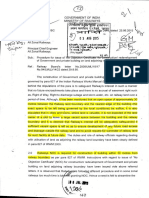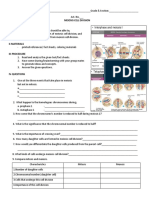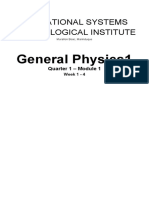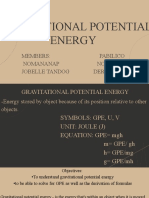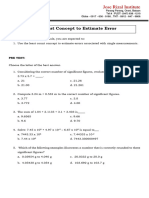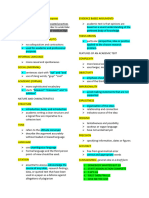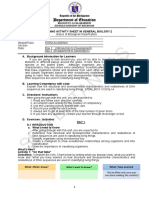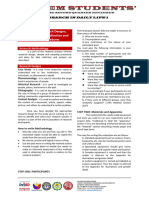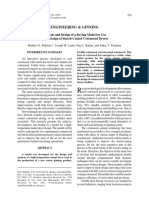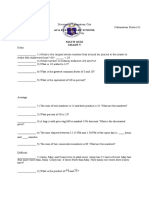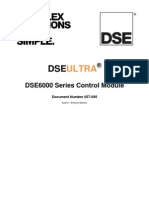Questionnaire
Uploaded by
Guia Emary EneroQuestionnaire
Uploaded by
Guia Emary EneroELECTRONIC STRUCTURE OF AN ATOM QUESTIONNAIRE
PREPARED BY YELLOW GROUP
1. Before 1925, quantum theory
a) faced little challenge to its credibility
b) lacked organization
c)had wide applications
d) was widely accepted
2 Generally, the mathematics of modern quantum mechanics is
a) perfunctory
b) unimportant
c)simplified
d) complex
3. Schrodinger's equation described the
a)procedure for splitting an atom
b)complement of the wave function
c)behavior of "matter" waves
d)motion of light
4. Solutions to Schrodinger's equation are labeled with
a) psi
b) phi
c) mu
d) pi
5. Which physicist proposed the uncertainty principle in 1927?
a) Niels Bohr
b)Albert Einstein
c)Arnold Schrodinger
d)Werner Heisenberg
6.What energy level is closest to the nucleus?
A.5th
C.2nd
B.3rd
D.1st
7.In the types of sublevels,what sublevels has a highest energy?
A.p
B.d
C.f
D.s
8.what is the shape of the p sublevel?
A.Spherical
B.Complex
C.Dumbbell
9.What is the total numbers of electrons in the 3rd energy level?
A.8
B.10
C.14
D.18
10.How many electrons holds in every orbital?
A.3
B.2
C.1
D.4
WRITE YOUR ANSWER IN A PROVIDED SPACE
___________ a LAPNICRIP – It is the quantum number that represents the energy level the electron is in.
___________ b LATOBRI – It is a representation of the wave function of a hydrogen-like atom.
___________ c ALGANUR MUTMENMO – It is a quantum number that represents the shape of orbitals.
___________ d NOTRECLE – It is the particle that can be described by four quantum numbers
___________ e MEGATINC – It represents the quantum number that describes the orientation of an
orbital.
___________ f NEREGY EVELL – It is being represented by n.
___________ g RHEPES – It is the shape of the s orbital.
2. Give the n and ℓ values for the following orbitals
a. 1s _______________________________
b. 3p _______________________________
c. 5f _______________________________
d. 4d _______________________________
3. What is the mℓ values for the following types of orbitals?
a. s _______________________________
b. p _______________________________
c. d _______________________________
d. f _______________________________
4. How many possible orbitals and how many electrons can inhabit the energy level n
a. 4 _______________________________
b. 5 _______________________________
5. State the number of possible electrons described by the following quantum numbers
a. n = 3, l = 0 _______________________________
b. n = 3, l = 1 _______________________________
c. n = 3, l = 2, ml = -1 ________________________
d. n = 5, l = 0, mℓ =-2, ms =-1/2 _________________
6. Which of the following is not a valid set of quantum numbers? Explain your answer.
a. n = 2, l = 2, ml = 0, and ms = -1/2
b. n = 2, l = 1, ml = -1, and ms = -1/2
c. n = 3, l = 0, ml = 0, and ms = 1
d. n = 3, l = 2, ml = 3, and ms = ½
7. What is the maximum electron pairs that can occupy an:
a. s orbital _______________________________
b. the subshell of p orbitals _______________________________
c. the subshell of d orbitals _______________________________
d. the subshell of f orbitals _______________________________
e. the subshell of g orbitals _______________________________
8. INDICATE THE ELECTRON CONFIGURATION, NOBLE GAS CONFIGURATION, AND NO. OF ELECTRONS.
MOREOVER, DRAW AN ORBITAL DIAGRAM AND INDICATE IF IT IS PARAMAGNETIC OR DIAMAGNETIC.
A. NE
B. O
ANSWER KEY
1. B
2. D
3. C
4. A
5. D
6. D
7. C
8. C
9. D
10. B
1. Rearrange the letters
a. Principal
b. Orbital
c. Angular momentum
d. Electron
e. Magnetic
f. Energy level
g. Sphere
2. Give the n and ℓ values
a. n=1, l = 0
b. n=3, l =1
c. n= 5, l= 3
d. n= 4, l=2 3.
3. mℓ values
a. ml= 0
b. ml= -1, 0,1
c. ml= -2, -1, 0, 1, 2
d. ml= -3, -2, -1, 0, 1, 2, 3
4. Possible Orbitals
a. 32 electrons
b. 50 electrons
5. Number of possible electrons
a. 2
b. 6
c. 2
d. not possible
6. Valid Set of Quantum Numbers
a. l =2 is not allowed, maximum is 1
b. possible
c. ms should only be ½ or -1/2
d. mℓ should only be within the values of 2l+1; mℓ should only be
within the values of 2l+1
7. Maximum electron pairs
a. 1
b. 3
c. 5
d. 7
e. 9
___________
You might also like
- Chapter 5: Chemical Bond Stability of Noble GasesNo ratings yetChapter 5: Chemical Bond Stability of Noble Gases20 pages
- General Chemistry 1 Activity Sheet Quarter 2-MELC 12 Week 6No ratings yetGeneral Chemistry 1 Activity Sheet Quarter 2-MELC 12 Week 69 pages
- GeneralChemistry1 - Q2 - Module-2 - Electron Configuration and Magnetic Property - v5No ratings yetGeneralChemistry1 - Q2 - Module-2 - Electron Configuration and Magnetic Property - v520 pages
- Activity 4 Know Me Better: Jed Enjelo C. Pabe STEM 12 ANo ratings yetActivity 4 Know Me Better: Jed Enjelo C. Pabe STEM 12 A6 pages
- Quarter 2 - MELC 17-20 Week 4: General Physics 1 Activity SheetNo ratings yetQuarter 2 - MELC 17-20 Week 4: General Physics 1 Activity Sheet12 pages
- Attracted To Intermolecular Forces Part A: Frayer Model of Liquids and SolidsNo ratings yetAttracted To Intermolecular Forces Part A: Frayer Model of Liquids and Solids6 pages
- 9.percent Composition Practice WS - Chemical Formula100% (1)9.percent Composition Practice WS - Chemical Formula4 pages
- Specialized 12 GeneralPhysicsI Semi CLAS4 Uniformly-Accelerated-Linear-MotionNo ratings yetSpecialized 12 GeneralPhysicsI Semi CLAS4 Uniformly-Accelerated-Linear-Motion28 pages
- General Chemistry 2 Quarter 3 Week 1 Module 1 Kinetic Molecular Model3386No ratings yetGeneral Chemistry 2 Quarter 3 Week 1 Module 1 Kinetic Molecular Model338618 pages
- General Chemistry 1: Quarter 2 - Week 1No ratings yetGeneral Chemistry 1: Quarter 2 - Week 113 pages
- GENERAL PHYSICS 1 GRADE 12 Q1 Summative Test 1 5No ratings yetGENERAL PHYSICS 1 GRADE 12 Q1 Summative Test 1 55 pages
- GB2 LAS Q3 W7A Bases of Bio ClassificationNo ratings yetGB2 LAS Q3 W7A Bases of Bio Classification9 pages
- Example of Information Brochure For Disaster and Risk Reduction ManagementNo ratings yetExample of Information Brochure For Disaster and Risk Reduction Management2 pages
- Techniques in Selecting and Organizing InformationNo ratings yetTechniques in Selecting and Organizing Information65 pages
- General Chemistry 2: Learning Activity SheetNo ratings yetGeneral Chemistry 2: Learning Activity Sheet55 pages
- Physical Science SHS 3.1 The Classical ElementsNo ratings yetPhysical Science SHS 3.1 The Classical Elements22 pages
- AP Chemistry Quantum Numbers Worksheet F 2012No ratings yetAP Chemistry Quantum Numbers Worksheet F 20125 pages
- 01.10.2024 Combined Test For 12th Math Batch Main PatternNo ratings yet01.10.2024 Combined Test For 12th Math Batch Main Pattern16 pages
- Ai-Driven Growth of Dsos: Practice Analysis and AffiliationNo ratings yetAi-Driven Growth of Dsos: Practice Analysis and Affiliation4 pages
- Controllogix™ Battery Module: Installation InstructionsNo ratings yetControllogix™ Battery Module: Installation Instructions32 pages
- Geog Gr 12 Geography Pre- test 1 marking guideline 2025No ratings yetGeog Gr 12 Geography Pre- test 1 marking guideline 20254 pages
- BJT Biasing Using A Current Source LectureNo ratings yetBJT Biasing Using A Current Source Lecture5 pages
- On Families of Generalized Pareto Distributions: Properties and ApplicationsNo ratings yetOn Families of Generalized Pareto Distributions: Properties and Applications20 pages
- Socio - Cognitive Biases Are Associated To Belief in Neuromyth and Cognitive EnhancementNo ratings yetSocio - Cognitive Biases Are Associated To Belief in Neuromyth and Cognitive Enhancement5 pages
- Amtrak Texas Eagle Dining Car Menu 201104No ratings yetAmtrak Texas Eagle Dining Car Menu 2011042 pages
- Cover Template - Left To Right: Hardcover BookNo ratings yetCover Template - Left To Right: Hardcover Book1 page
- Determination of Potential Alkali Reactivity of Cement-Fine AggregateNo ratings yetDetermination of Potential Alkali Reactivity of Cement-Fine Aggregate4 pages
- Lesson Title: Digestion/Absorption of Nutrients: 7 Grade General Science CourseNo ratings yetLesson Title: Digestion/Absorption of Nutrients: 7 Grade General Science Course5 pages
